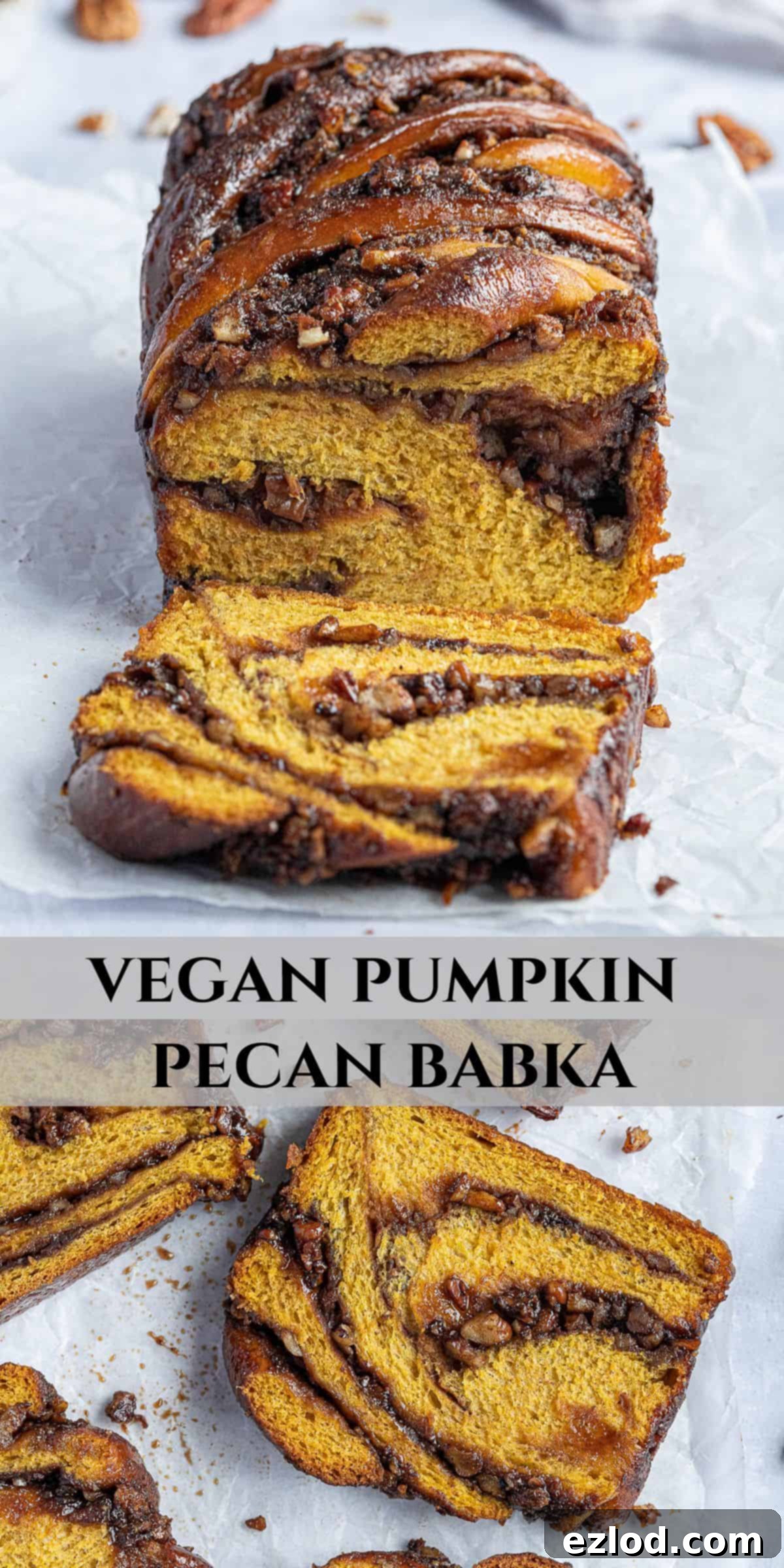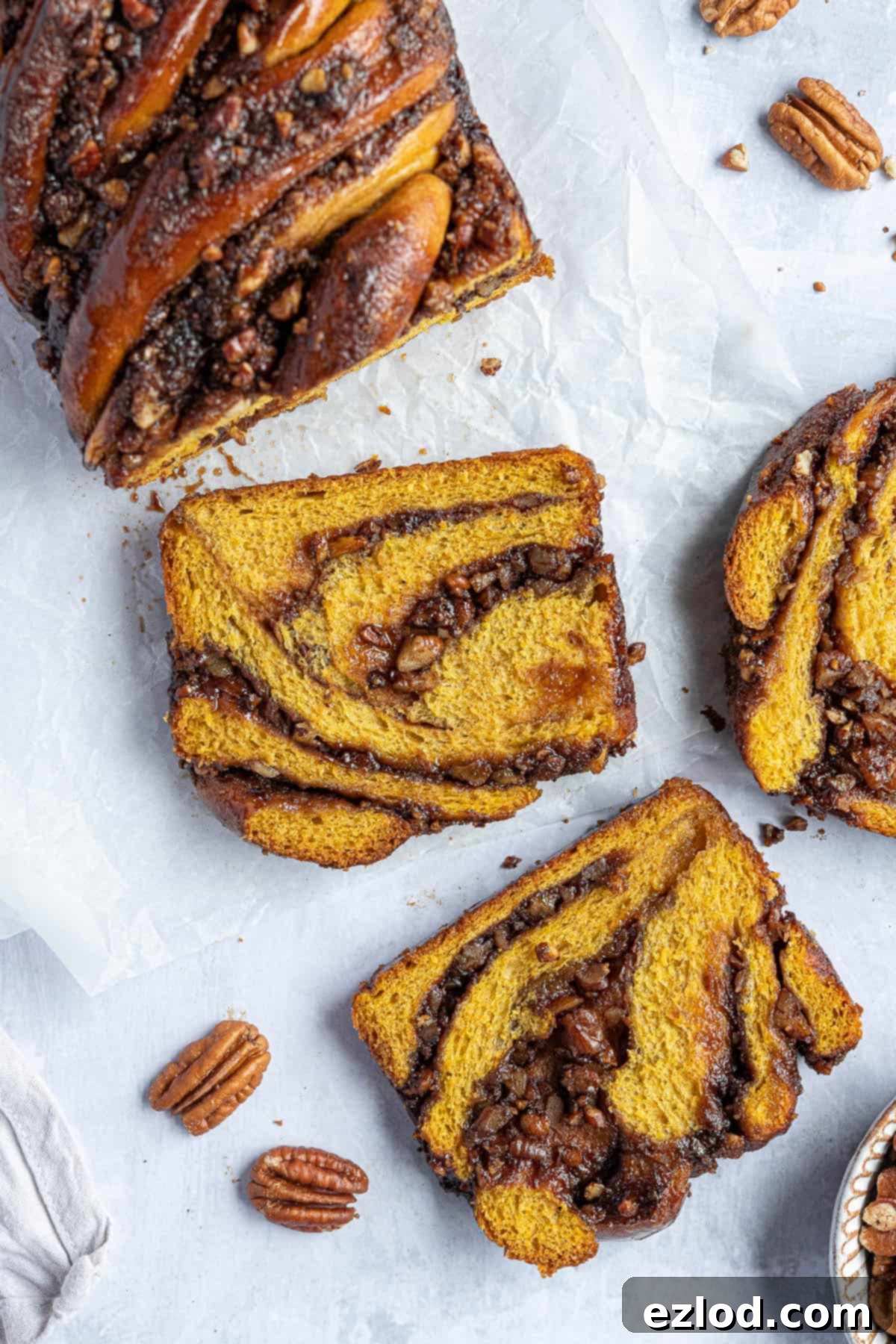Delicious Vegan Pumpkin Pecan Babka: Your Ultimate Fall Baking Guide
Embrace the cozy flavors of autumn with this incredible Vegan Pumpkin Pecan Babka! This sweet, sticky, and utterly irresistible loaf is the perfect centerpiece for your fall baking adventures. Imagine a soft, brioche-like pumpkin bread dough, generously swirled with a rich, spiced brown sugar pecan filling, all doused in a glistening, sweet syrup. It’s not just a treat; it’s an experience – the ultimate indulgence for a crisp autumn day, best enjoyed with a warm cup of tea or coffee.
This recipe transforms a classic favorite into a remarkable plant-based delight, proving that you don’t need eggs or dairy to achieve a beautifully tender and deeply flavorful babka. The secret lies in carefully selected vegan ingredients and a bit of patience, allowing the flavors to meld and the dough to develop its signature texture.
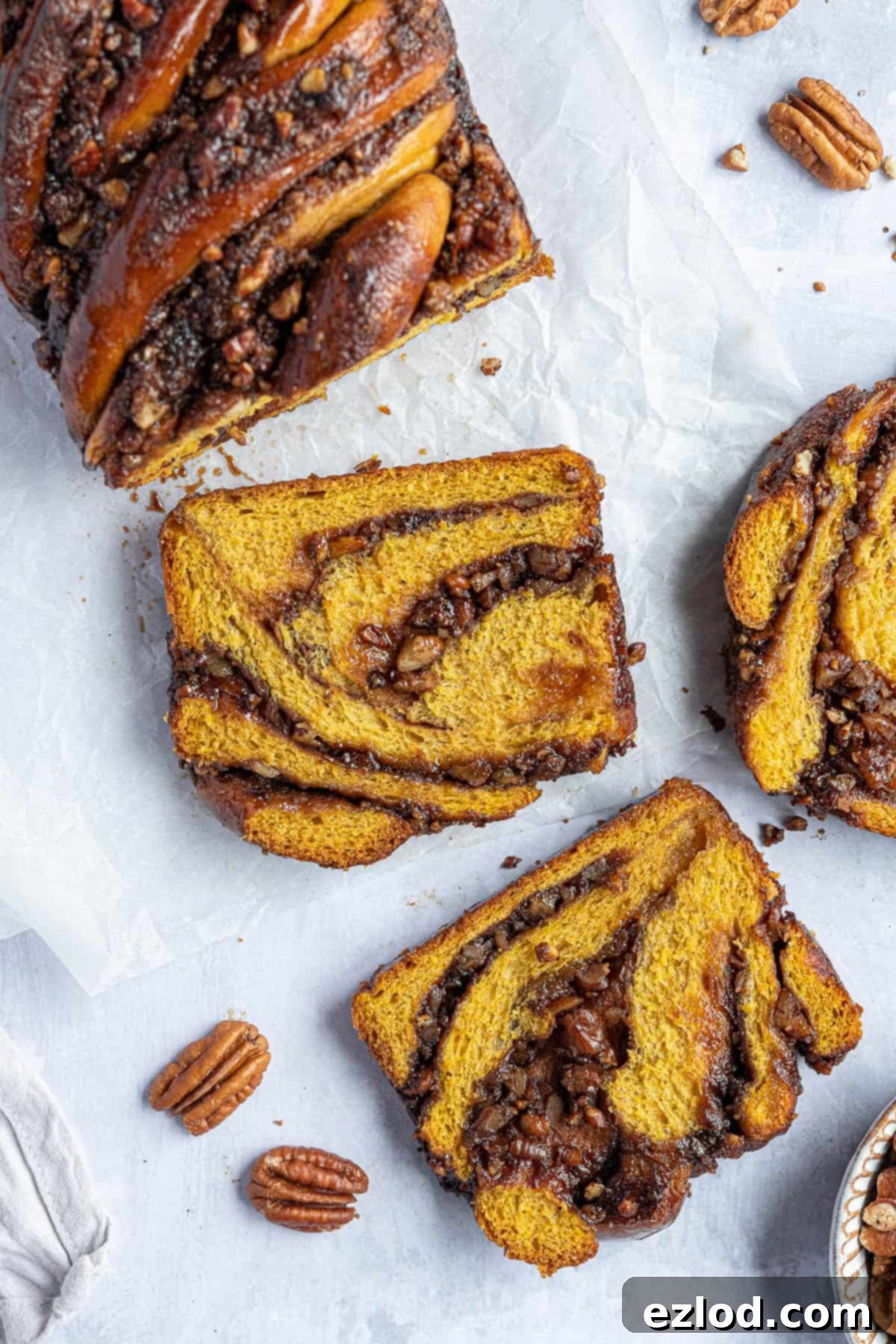
Our vegan pumpkin pecan babka is characterized by its soft, gooey interior, its aromatic pumpkin spice notes, and a satisfying richness that will leave you wanting more. The tender, brioche-style pumpkin bread dough forms the perfect canvas for a truly decadent, sticky, and “buttery” pumpkin-spiced pecan filling. You won’t find any obscure ingredients here; just simple, plant-based staples combine to create something truly magical. After baking, a generous brushing of sugar syrup not only imparts a beautiful sheen but also locks in moisture, ensuring your babka stays delightfully fresh and moist for several days.
While making babka might seem a bit daunting at first due to the various steps, it’s actually quite straightforward and incredibly rewarding. Much of the process involves “hands-off” time, allowing the dough to rise and flavors to develop. For the best results and an enhanced depth of flavor, we highly recommend a two-day approach. Prepare the dough on the first day and let it rise slowly overnight in the fridge. This cold fermentation not only deepens the flavor profile but also firms up the dough, making it much easier to handle, roll, and shape on the following day. If time is of the essence, you can certainly complete the entire process in one day, though the overnight rise offers an undeniable advantage.
What Exactly Is Babka? A Sweet Bread Tradition
Babka is a beloved sweet, cake-like braided yeast bread with a rich history, originating in the Polish Jewish community during the early 19th century. Often referred to as a krantz cake in some traditions, its name, “babka,” charmingly translates to “grandmother” in Polish, possibly due to its resemblance to a grandmother’s pleated skirt or the loving care put into its creation.
Typically, babka features a soft, tender, and often enriched brioche-style dough. This dough is meticulously rolled out, spread with a delicious filling – which can range from classic cinnamon or chocolate to various fruit or nut concoctions – then carefully rolled up and braided before being baked to golden perfection. The braiding technique creates those beautiful, mesmerizing swirls of filling that make babka so visually appealing and incredibly satisfying with every bite. Our vegan pumpkin pecan babka proudly carries on this tradition, offering a modern plant-based twist on a timeless classic.
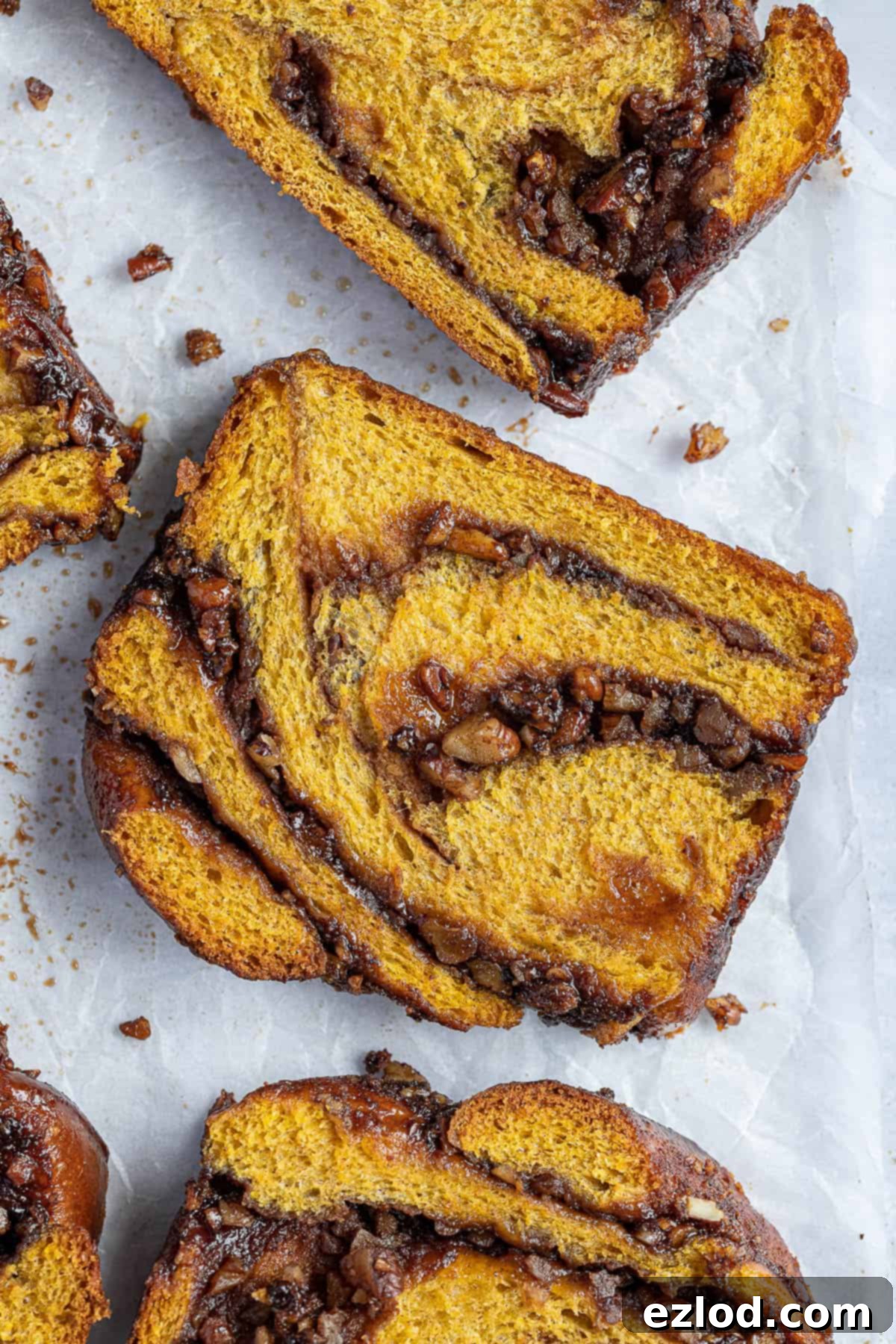
Essential Ingredients for Your Vegan Pumpkin Pecan Babka
Crafting the perfect vegan pumpkin pecan babka starts with selecting the right ingredients. Here’s a detailed look at what you’ll need and why each component is important:
- Bread Flour: For that wonderfully soft, fluffy, and slightly chewy texture characteristic of great babka, white bread flour is your best choice. Its higher protein content develops more gluten, which is essential for the dough’s structure and elasticity. While all-purpose (plain) flour can work, the final texture might be slightly less robust. We strongly advise against using wholemeal flour, as it will likely result in a denser, heavier loaf that lacks the desired light brioche quality.
- Instant/Fast-Action Yeast: To keep the process smooth and efficient, we recommend using instant or fast-action yeast. This type of yeast can be mixed directly with the dry ingredients without prior activation, saving you a step. If you only have active dry yeast, don’t worry! Refer to our “What Kind of Yeast?” section below for simple activation instructions.
- Salt: A non-negotiable ingredient in any bread recipe, salt is crucial for flavor enhancement and regulating yeast activity. It prevents the babka from tasting bland and helps to strengthen the gluten structure. Do not omit it!
- Pumpkin Puree: This key ingredient infuses the babka dough with a lovely subtle pumpkin flavor and a beautiful golden hue. More importantly, it adds significant moisture, contributing to the incredibly soft texture. Always use 100% pumpkin puree (often found in cans), not pumpkin pie filling, which contains added spices and sugar. If canned puree isn’t available, we provide instructions for making your own from scratch further down.
- Vegan Block Butter: For superior richness and texture, a high-quality vegan block butter or margarine is preferred over spreadable varieties in tubs. Block butter typically has a lower water content, mimicking dairy butter more closely and yielding better baking results. Brands like Naturli Vegan Block are excellent choices, but any firm vegan butter will work. If spreadable is all you have, it will still work, but you might notice a slight difference in dough consistency.
- Non-Dairy Milk: Unsweetened non-dairy milk is used to provide liquid for the dough. Soy milk is often favored for baking due to its higher protein content, which can closely resemble the properties of dairy milk in recipes. However, feel free to use any unsweetened plant-based milk you prefer, such as almond, oat, or cashew milk. Just ensure it’s unsweetened to avoid altering the sugar balance of the recipe.
- Sugar: This recipe utilizes two types of sugar for optimal results. Caster sugar (or granulated sugar) is used in the dough and the finishing syrup, providing sweetness and contributing to browning. Brown sugar, particularly light or dark brown soft sugar (or even muscovado), is essential for the rich, moist filling. Using a mix of light and dark brown sugar in the filling can add depth of flavor. Do not substitute with artificial sweeteners or liquid sugars, as they will dramatically change the dough’s chemistry and the babka’s texture.
- Pecans: Pecans are a classic pairing with pumpkin and autumn spices, adding a delightful crunch and nutty flavor to the filling. If pecans aren’t your favorite, you can substitute them with other nuts like walnuts or almonds. For a simpler pumpkin spice babka without nuts, you can omit them entirely.
- Pumpkin Spice: A pre-mixed pumpkin spice blend makes this recipe incredibly convenient. While widely available in the US, it can sometimes be harder to find in other regions like the UK. If you’re in the UK, mixed spice is a similar but distinct blend. For an authentic pumpkin spice flavor, we provide an easy recipe to make your own blend from common spices below.
- Vanilla Extract: A touch of vanilla extract in the filling enhances the overall aroma and complements the pumpkin and spice flavors beautifully. While optional, it adds a lovely depth that is highly recommended.
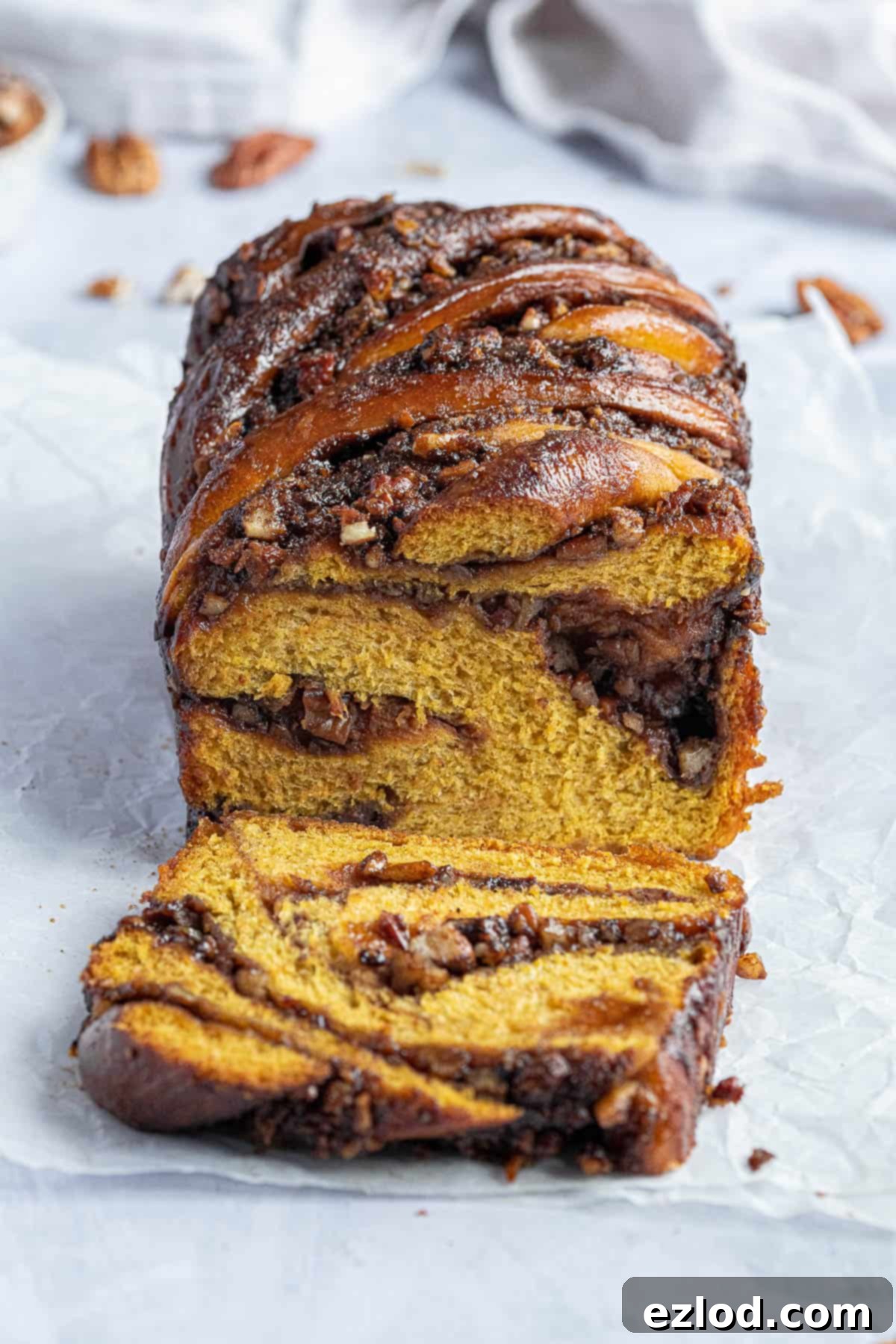
Step-by-Step Guide: How To Make Vegan Pumpkin Pecan Babka
(For precise measurements and detailed instructions, please refer to the comprehensive recipe card located at the bottom of this page.)
Making this vegan pumpkin pecan babka is a delightful process, best started the day before you plan to bake. This allows for a beneficial overnight rise that greatly enhances flavor and dough texture. If you’re short on time, a single-day process is also possible.
Day One: Preparing the Babka Dough
- Combine Dry Ingredients: In a large mixing bowl or the bowl of a stand mixer fitted with a dough hook, combine the bread flour, caster sugar, instant yeast, and salt. Whisk them together briefly to ensure even distribution.
- Add Wet Ingredients (Initial): Pour in the pumpkin puree and unsweetened non-dairy milk. Mix on low speed (or by hand with a sturdy spoon) until a rough, shaggy dough forms. Continue to knead for a few minutes until the dough starts to come together into a relatively smooth ball.
- Incorporate Vegan Butter: Add the softened vegan block butter to the dough. This is where patience is key! The dough may appear greasy and messy initially as the butter is worked in. Continue kneading, either with your stand mixer on medium speed or vigorously by hand, for 8-10 minutes. Gradually, the butter will be fully absorbed, and the dough will transform into a smooth, elastic, and slightly sticky consistency. It should pull away cleanly from the sides of the bowl. If it feels excessively wet, knead in a tiny bit more flour, but be cautious not to add too much, as this can result in a dry babka.
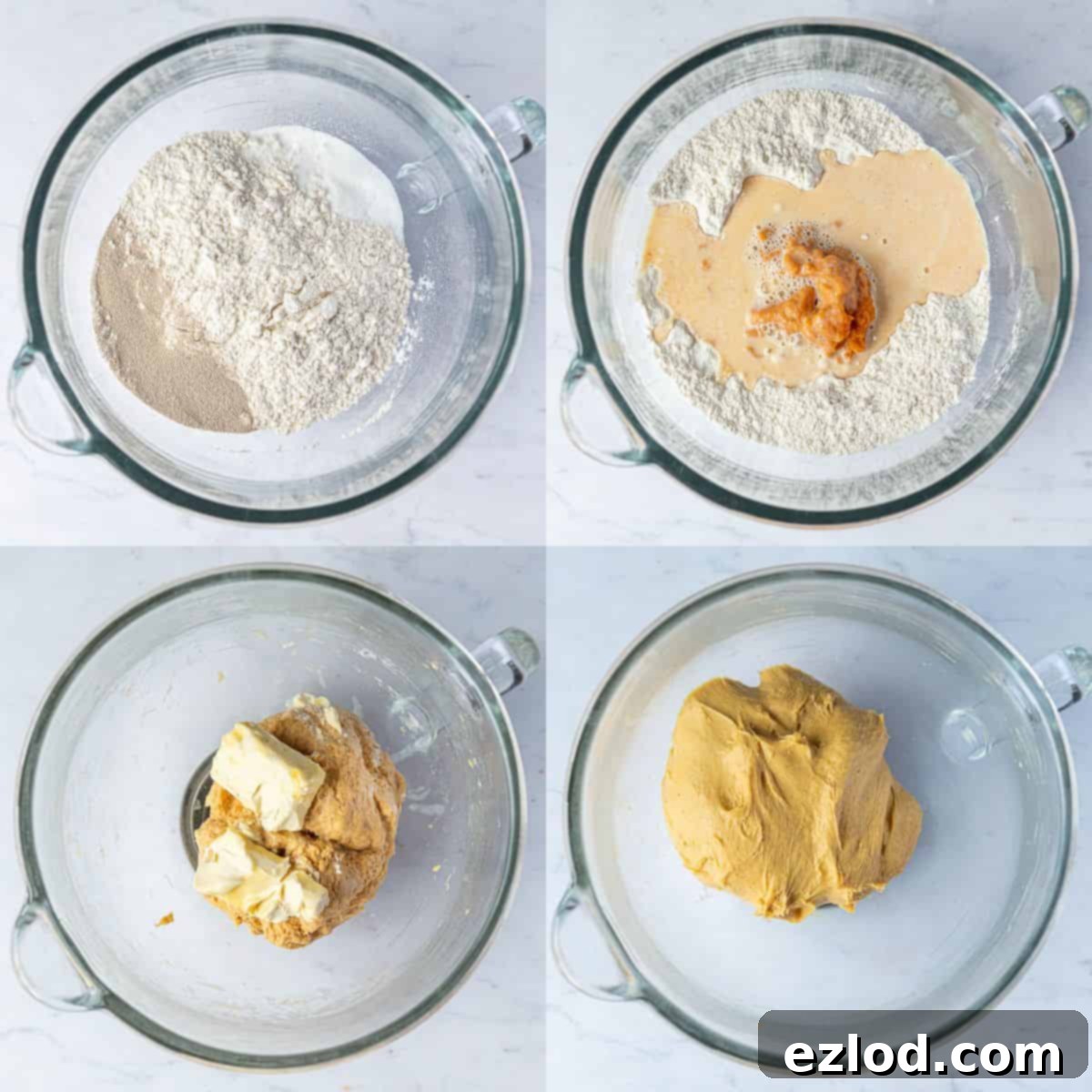
At this stage, your dough should look beautifully smooth and silky. It will still be soft and slightly tacky to the touch, which is ideal for a rich babka. Avoid the temptation to add excessive flour. A well-kneaded dough is the foundation of a light and airy babka.
- First Rise & Overnight Chill: Lightly oil a clean bowl. Transfer the dough to this bowl, turning it once to coat lightly with oil. Cover the bowl loosely with plastic wrap or a clean kitchen towel. Allow the dough to rise at room temperature for about 1 hour. Following this initial rise, place the covered bowl in the refrigerator to continue its slow rise overnight (for 8-12 hours). This extended cold fermentation is crucial for developing deep flavor and improving dough manageability.
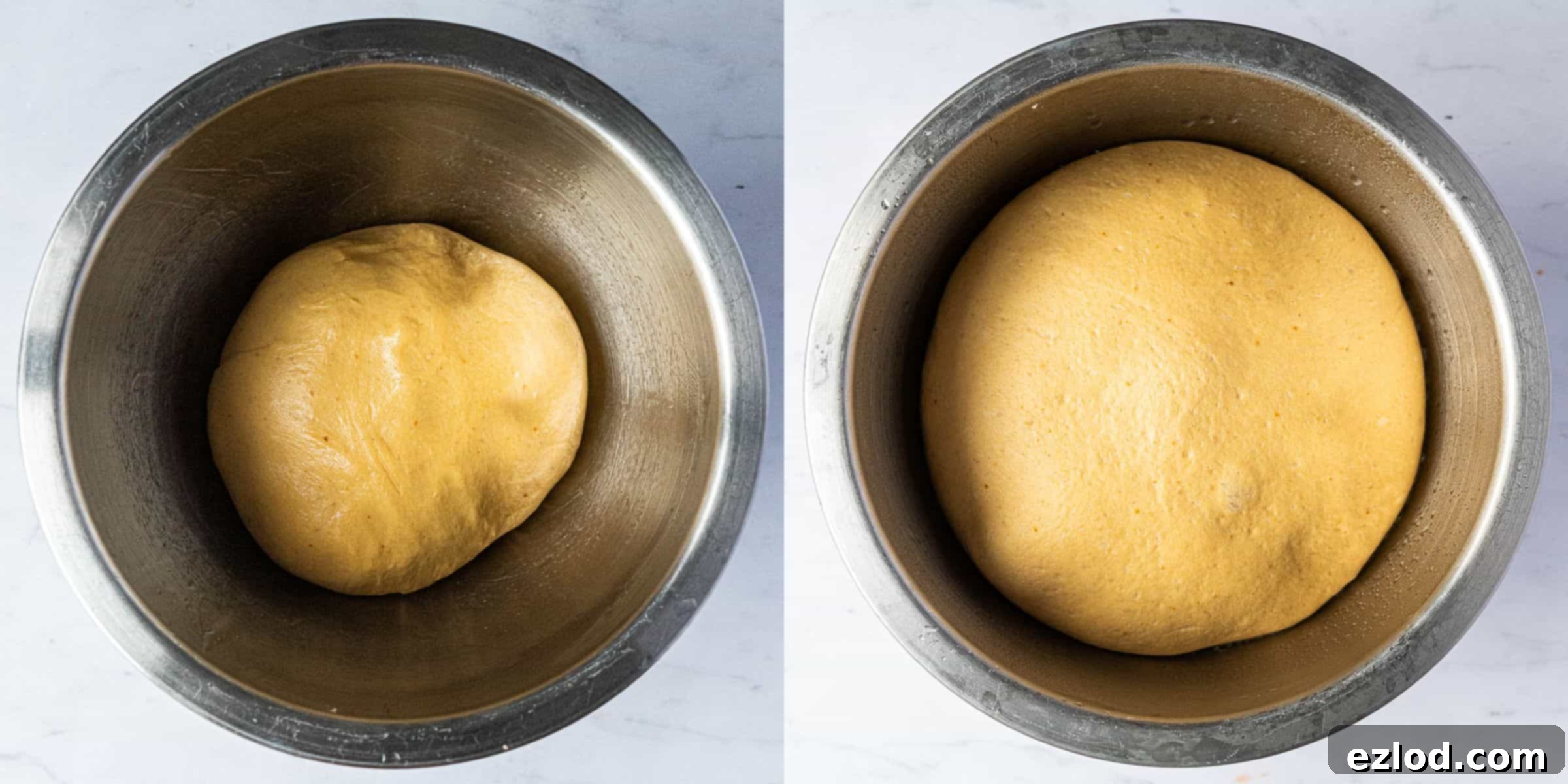
Day Two: Preparing the Filling and Shaping the Babka
- Prepare the Filling: The next day, your dough should have impressively doubled in size. Remove it from the fridge and set it aside to warm up slightly while you prepare the aromatic pecan filling. Finely chop the pecans – a food processor can make this task quick and easy. In a separate bowl, cream together the softened vegan butter, brown sugar, pumpkin spice, vanilla extract, and a pinch of salt until smooth and well combined. Then, fold in the finely chopped pecans until evenly distributed.
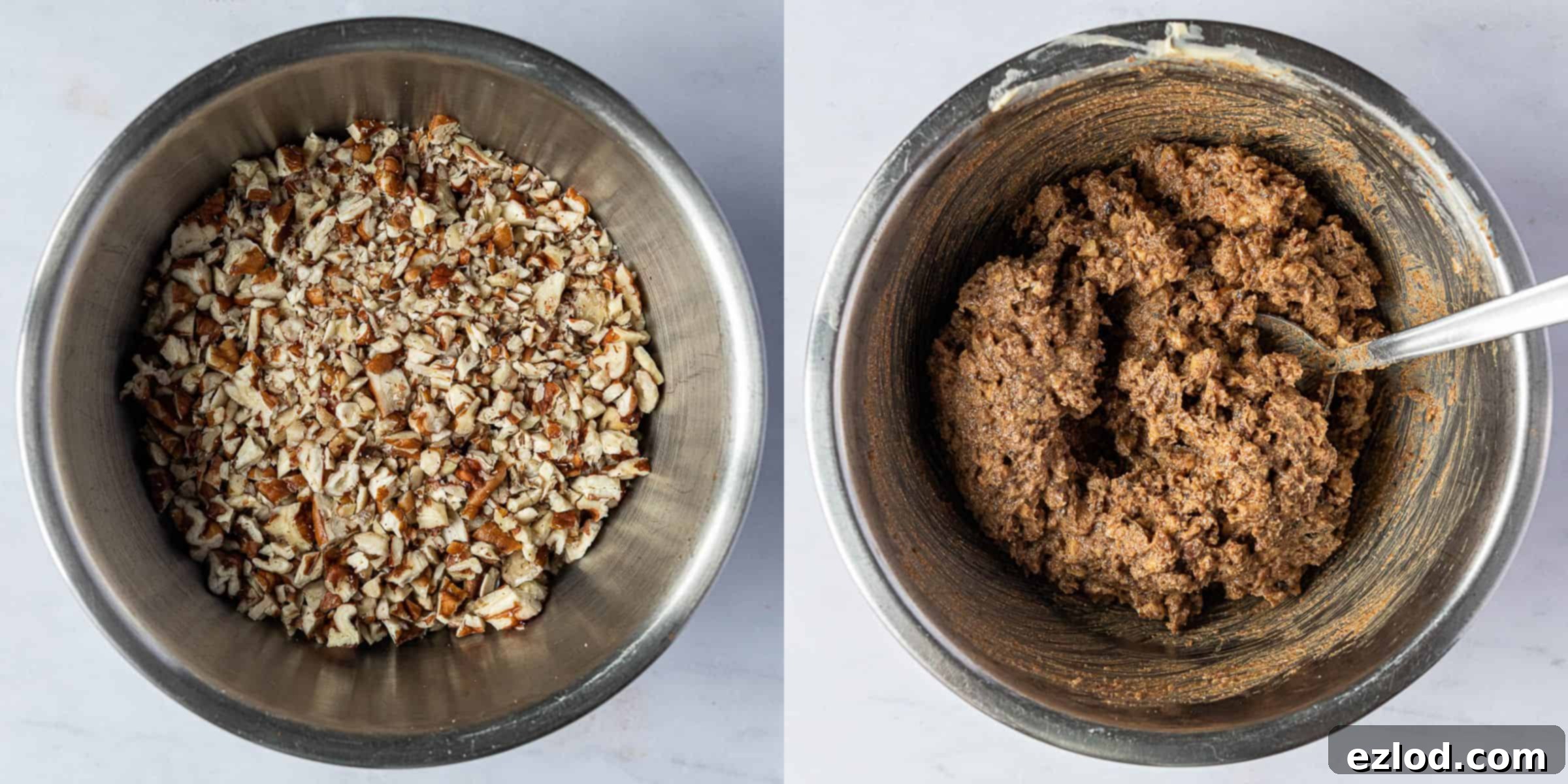
How To Shape Babka: The Art of the Swirl
- Roll Out the Dough: Gently punch down the chilled dough to release air. Transfer it to a lightly floured surface and roll it out into a large rectangle, approximately 30x40cm (11×15 inches). Aim for an even thickness across the dough.
- Spread the Filling: Evenly spread the prepared pecan filling over the entire surface of the rolled-out dough, leaving a small 1cm (½ inch) border along one of the long edges. This border will help seal the babka.
- Roll and Slice: Starting from the long edge opposite the border, tightly roll the dough into a neat sausage shape. Once rolled, use a sharp knife or a piece of unflavored dental floss to carefully cut the sausage lengthwise right down the middle, exposing the beautiful layers of filling.
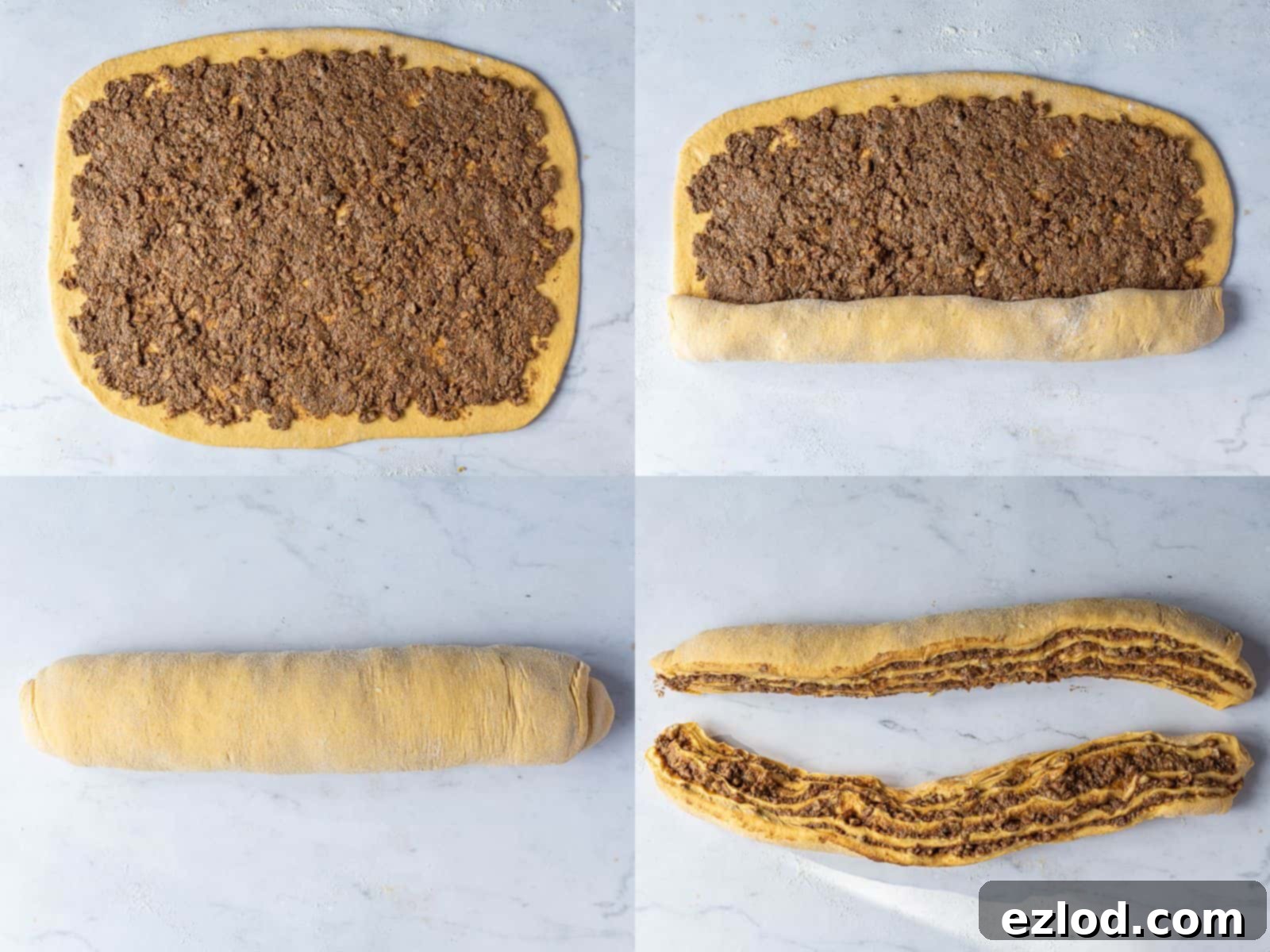
- Braid the Dough: With the cut sides facing up, carefully twist the two halves of the dough together to form a beautiful braid. Pinch the ends together firmly to seal.
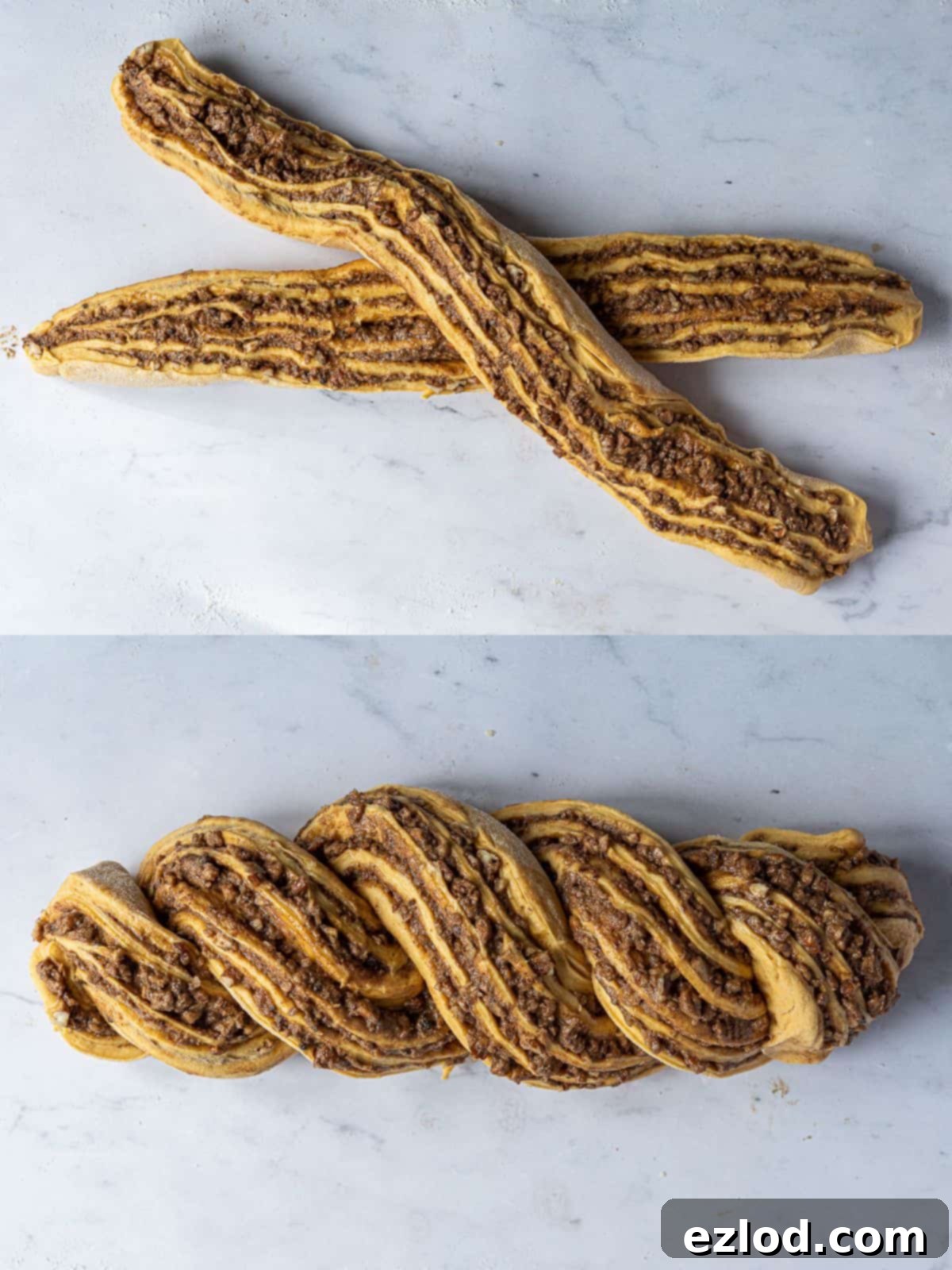
- Second Rise (Proofing): Grease an approximately 11.5 x 21.5 cm (4.5 x 8.5 inch) 2lb loaf tin and line it with baking parchment, ensuring some overhang to help with lifting later. Carefully transfer the braided babka into the prepared loaf tin, gently squishing it to fit if necessary. Loosely cover the tin with plastic wrap or a kitchen towel and let it rise in a warm spot until it has doubled in size, typically 1.5 to 2 hours. The exact timing will depend on your room temperature. It’s ready when it looks puffy and a gentle press on the exposed dough with a finger leaves a slight indentation that slowly springs back.
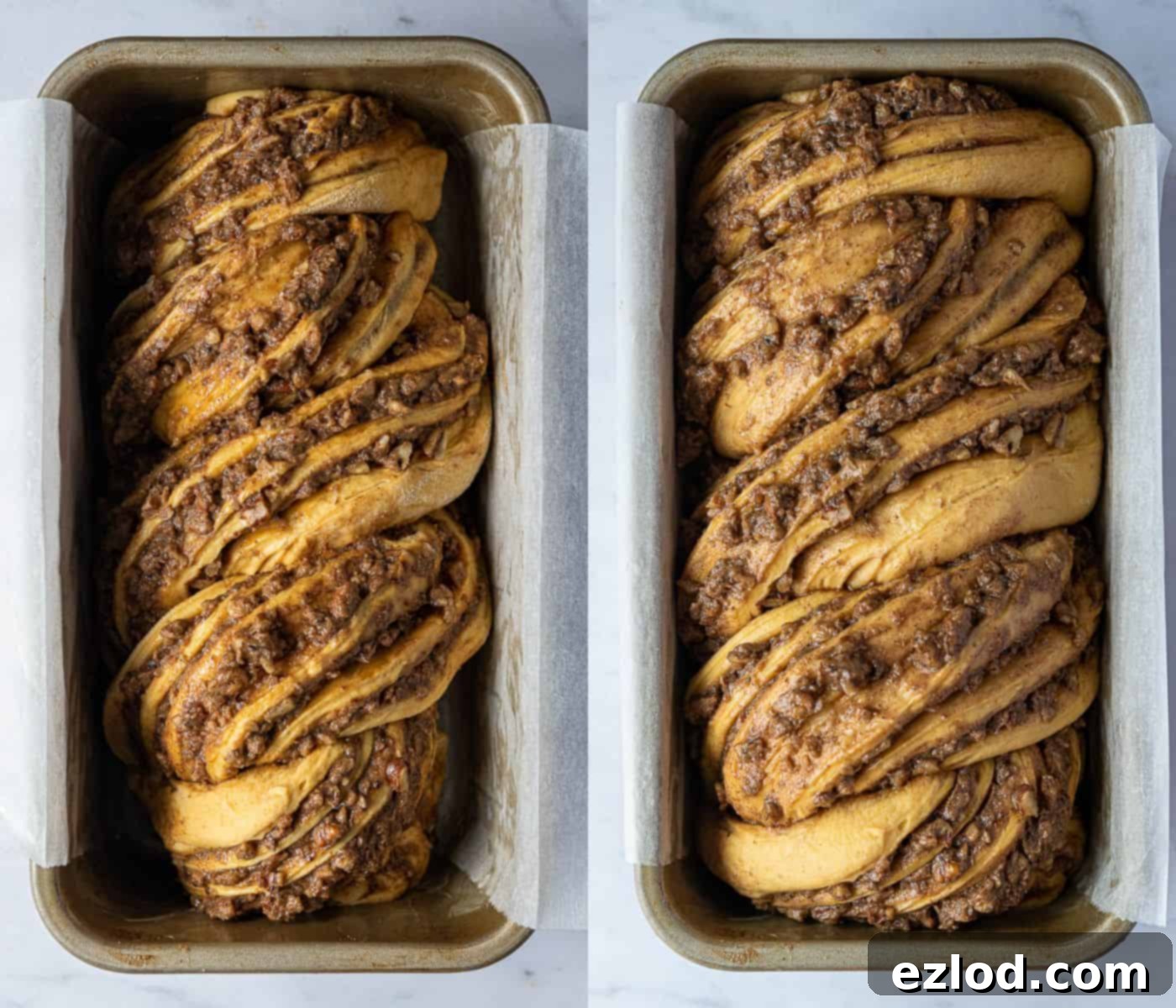
- Baking: While your babka is finishing its second rise, preheat your oven to 180°C (160°C fan/350°F/gas mark 4). Bake for approximately 45-50 minutes, or until the babka is deep golden brown and a probe thermometer inserted into the center reads around 90°C (195°F). If it starts to brown too quickly, loosely tent it with aluminum foil halfway through baking to prevent over-browning.
- Syrup Glaze: While the babka bakes, prepare the simple syrup. In a small saucepan, combine the caster sugar and water. Heat over medium heat, stirring until the sugar completely dissolves and the mixture comes to a gentle simmer. Remove from heat and set aside.
- Finishing Touch: As soon as the babka emerges from the oven, generously brush the entire top surface with the prepared sugar syrup. Continue brushing until all the syrup has been absorbed – it may seem like a lot, but trust the process for ultimate moisture and shine!
- Cooling: Allow the babka to cool in its tin for 15-20 minutes, giving it time to fully absorb the syrup. Then, carefully lift it out onto a wire rack using the parchment overhang and let it cool completely before slicing. This final cooling step is crucial for the texture to set properly.
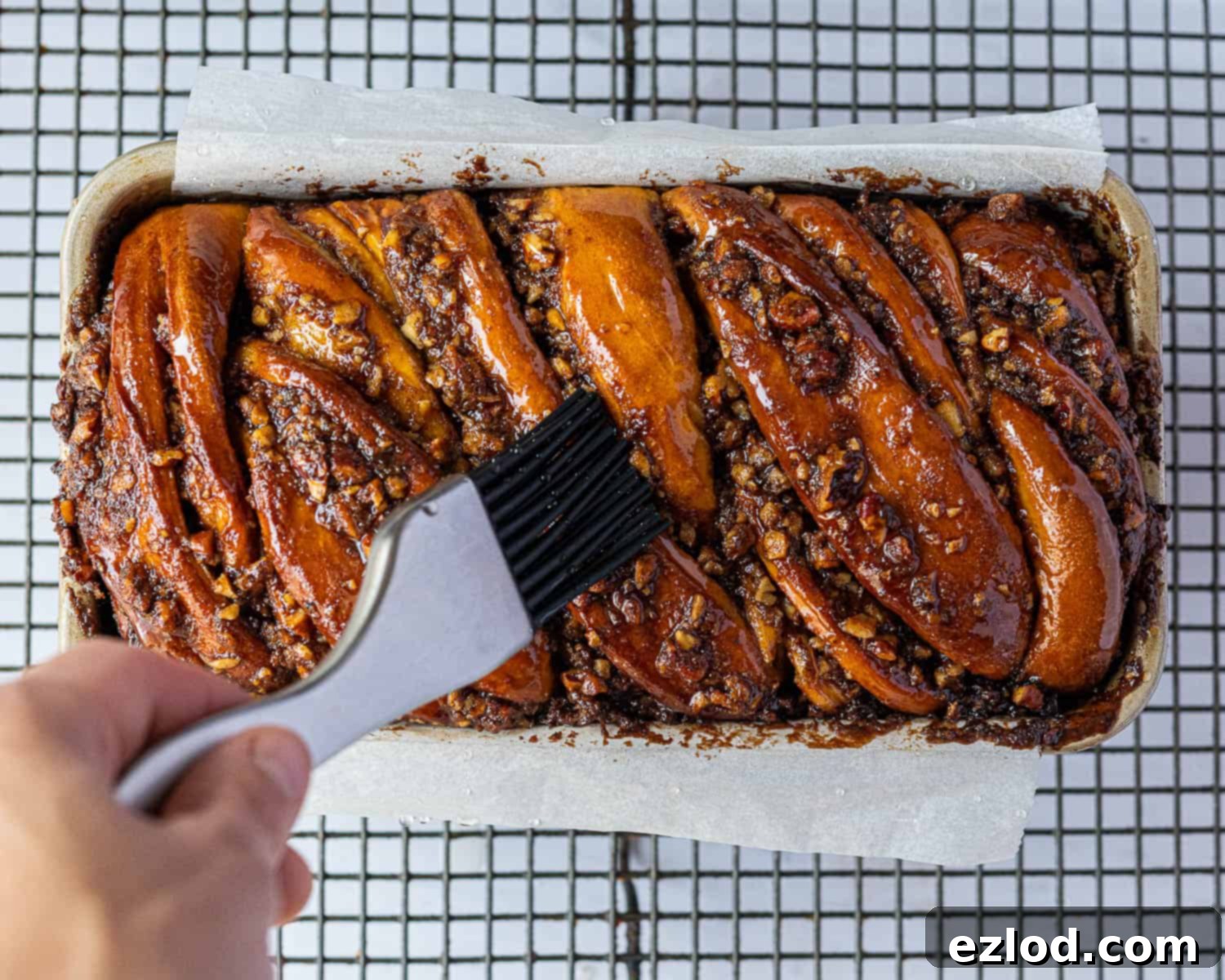
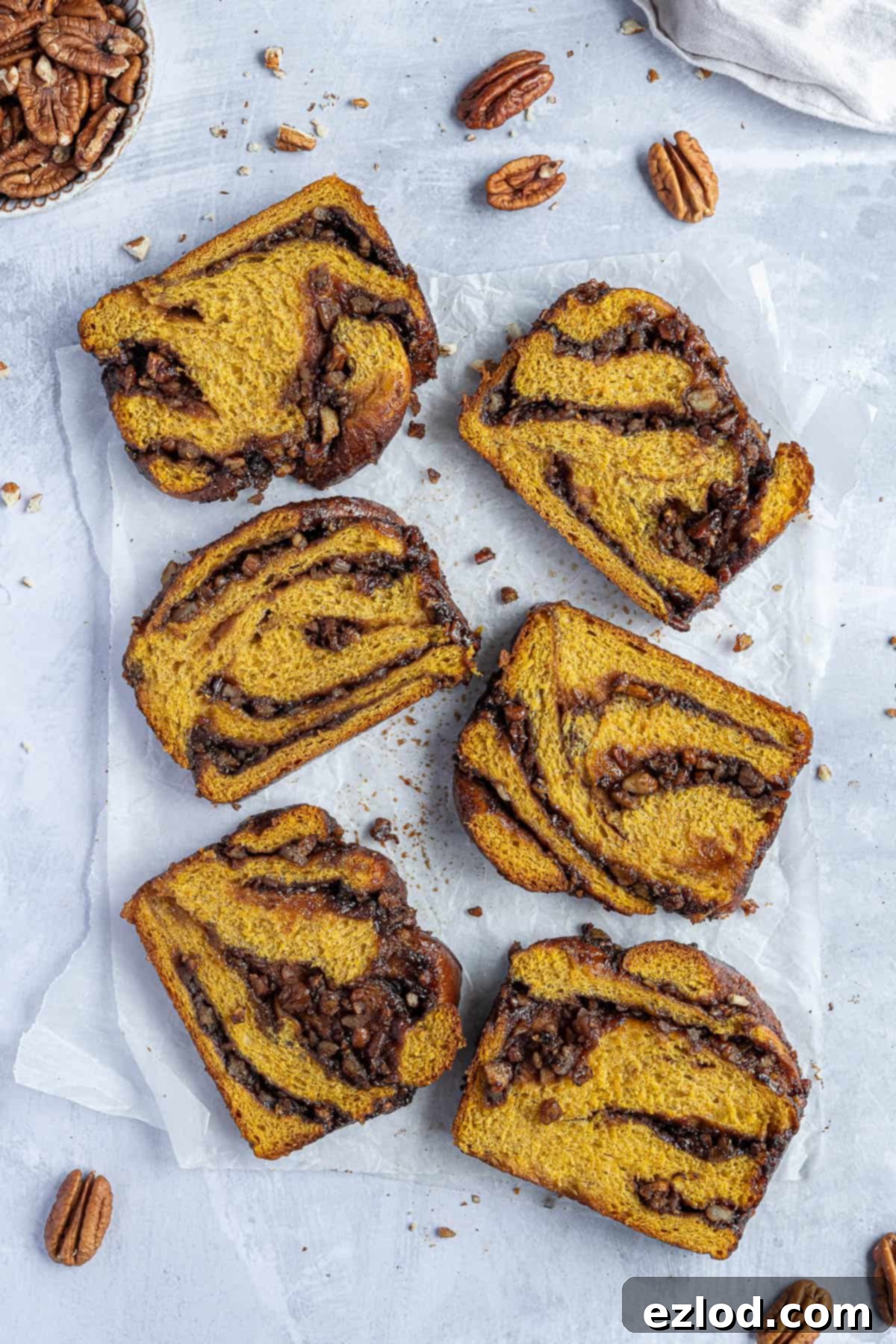
Expert Tips for a Perfect Vegan Babka Every Time
Achieving a show-stopping babka is easier with these valuable tips:
- Embrace Metric Measurements: For all baking recipes, and especially for bread where precision is key, we highly recommend using metric measurements with a digital kitchen scale. Cup conversions, especially for flour, can be incredibly inaccurate due to variations in how ingredients are packed. A scale provides far more consistent and reliable results, and it’s often less messy too!
- Yeast Check: Always confirm that your yeast is fresh and within its expiry date. Expired or inactive yeast is a common culprit for bread that fails to rise, leading to disappointment.
- Pumpkin Puree, Not Pie Filling: Double-check the label if you’re using canned pumpkin puree. Ensure it’s 100% pure pumpkin and not pumpkin pie filling, which contains added spices and sweeteners that will throw off the recipe’s balance.
- Temperature Matters for Rising: The time it takes for your dough to rise is highly dependent on ambient temperature. On warmer days, the dough will prove much faster than on cooler days. Keep an eye on the dough rather than strictly adhering to a timer.
- Mastering Doneness with a Thermometer: The most reliable way to know if your babka is fully cooked in the center is by using a probe thermometer. Oven temperatures can vary significantly, making a one-size-fits-all baking time unreliable. The babka is perfectly done when the internal temperature reaches 90°C (195°F).
- Patience is Key for Cooling: We know it’s tempting to slice into your warm, fragrant babka immediately, but resisting this urge is crucial. The babka continues to cook and set as it cools. Slicing it too soon can result in a dense or gummy texture. Allow it to cool completely for the best eating experience.
- Don’t Skip the Syrup: The sugar syrup brushed over the hot babka isn’t just for shine; it’s essential for keeping the babka beautifully moist and fresh for several days. It might seem like a generous amount of liquid, but trust the process – use all of it for a truly succulent loaf.
- Chocolate Variation: If you’re a chocolate lover, you can easily adapt this recipe to make a delicious chocolate pumpkin babka! Simply use the decadent filling recipe from our vegan chocolate babka.
- Hand Kneading: If you don’t own a stand mixer, fear not! This dough can absolutely be kneaded by hand. Just be prepared for a slightly messier, but equally rewarding, workout on an un-floured surface.
Understanding Yeast: Active Dry vs. Instant
Yeast is the magical ingredient that gives bread its airy texture and characteristic rise. We primarily use fast-action yeast (also known as instant or easy yeast) in our recipes because of its convenience – it can be added directly to dry ingredients without prior activation.
If your pantry only stocks active dry yeast, you can certainly still use it! The process is slightly different: you’ll need to “proof” or activate it first. To do this, mix the active dry yeast with a portion of the lukewarm non-dairy milk (from the recipe’s total liquid) and a pinch of the sugar (also from the recipe’s total sugar). Let this mixture sit for 10-20 minutes in a warm place until it becomes noticeably foamy and bubbly. This indicates the yeast is active and ready to work. Once activated, proceed with the rest of the recipe as written, adding the yeast mixture when the milk and pumpkin puree are called for.
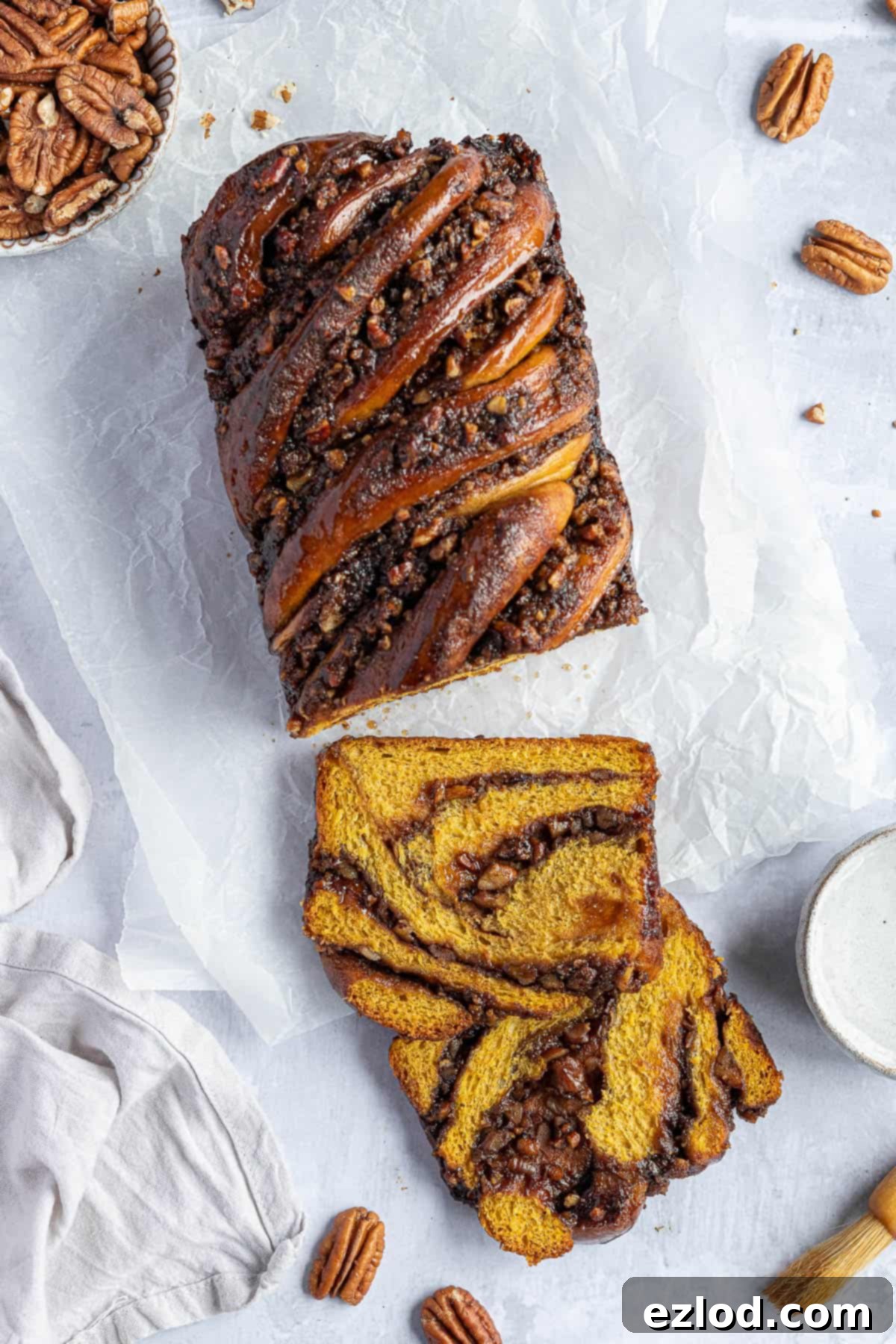
Crafting Your Own Pumpkin Pie Spice Blend
While pumpkin pie spice is a pantry staple in the US, it can be surprisingly elusive in other parts of the world, like the UK (though some stores are starting to catch on!). While “mixed spice” is a common UK equivalent, its blend of spices differs from traditional pumpkin spice, meaning it won’t yield quite the same authentic flavor profile. The fantastic news is that making your own pumpkin spice blend from scratch is incredibly simple, requiring just a few common ground spices you likely already have on hand: cinnamon, ginger, nutmeg, cloves, and allspice.
To create your custom blend, simply mix together the following: 3 tablespoons ground cinnamon, 2 teaspoons ground ginger, 2 teaspoons ground nutmeg, 1 teaspoon ground cloves, and 1 teaspoon ground allspice. This ratio will give you a robust and fragrant spice blend that perfectly captures the essence of autumn. You can easily halve this recipe if you only need a smaller quantity for a single baking project. However, we recommend making a full batch, as homemade pumpkin pie spice stores wonderfully in an airtight container for an extended period. It’s ideal for all your seasonal bakes, from pies and muffins to lattes and, of course, this delicious babka!
Homemade Pumpkin Puree: A Fresh Alternative
For this vegan pumpkin pecan babka, tinned pumpkin puree is a convenient choice, often found in the “American section” of larger supermarkets or online. However, if you can’t locate it, or simply prefer to use fresh ingredients, making your own pumpkin puree is surprisingly easy and rewarding. The key is to select an “eating pumpkin” or a butternut squash, rather than a large carving pumpkin, as eating varieties have sweeter, denser flesh.
Here’s how to make it: Begin by halving your chosen pumpkin or butternut squash and scooping out all the seeds and fibrous strands. Place the halves cut-side down on a baking tray. Roast them in an oven preheated to approximately 200°C (400°F/gas mark 6) until the flesh is completely tender and can be easily pierced with a fork. The roasting time will vary significantly depending on the size and type of your squash, so monitor it closely. Once tender, allow it to cool slightly, then scoop the soft flesh out of the skin and transfer it to a food processor or blender. Process until you achieve a smooth, consistent puree. Avoid boiling the pumpkin, as this can introduce too much water, resulting in a thin, watery puree that isn’t ideal for baking.
Storage and Freezing Guidelines for Vegan Pumpkin Pecan Babka
Like most homemade bread, this vegan pumpkin pecan babka is at its peak freshness on the day it’s baked. However, thanks to that generous syrup glaze, it maintains its delightful moisture and softness for approximately 3 days when stored correctly. To revive its fresh-baked aroma and texture, gently warm slices before serving.
Store your babka in an airtight container or a traditional bread bin at room temperature. It’s important to avoid refrigerating bread products like babka, as the cold environment can accelerate the staling process, making it dry out faster.
Can You Freeze Vegan Pumpkin Pecan Babka?
Absolutely! This vegan pumpkin pecan babka freezes beautifully, making it perfect for meal prepping or saving for a future treat. You can freeze it either as a whole loaf or conveniently sliced into individual portions. To freeze, simply place the completely cooled babka (or slices) into a ziplock bag or airtight freezer-safe container. It will keep well in the freezer for up to three months. For optimal freshness, it’s best to freeze it on the same day it’s baked, once it has fully cooled.
When you’re ready to enjoy it, allow the babka to defrost at room temperature. For a truly delicious experience, gently warm it through in the oven or microwave before serving to bring back its fresh-baked warmth and softness.
Can This Recipe Be Made Gluten-Free?
Unfortunately, adapting this vegan pumpkin pecan babka recipe to be gluten-free is not recommended. The intricate structure and chewy texture of babka heavily rely on the gluten development from wheat flour. Creating a successful gluten-free yeast bread is a complex culinary endeavor that requires a completely different approach to ingredient ratios and techniques. Gluten-free baking is a specialized field, and attempting to simply substitute gluten-free flour in this recipe would likely result in a dense, crumbly, and unpalatable loaf.
For those requiring a gluten-free option, your best bet is to seek out a recipe specifically designed for gluten-free babka or sweet bread, as these will have been carefully formulated to account for the absence of gluten.
More Delicious Sweet Vegan Bread Recipes:
If you loved this vegan pumpkin pecan babka, be sure to explore our other fantastic vegan bread recipes:
- Vegan Chocolate Babka
- Vegan Pumpkin Cinnamon Rolls
- Almond Bread Twist
- Classic Vegan Cinnamon Rolls
- Vegan Hot Cross Buns
- Maple Pecan Bread Wreath
- Vegan Banana Bread Cinnamon Rolls
- Vegan Lemon Blueberry Rolls
- Vegan Gingerbread Cinnamon Rolls
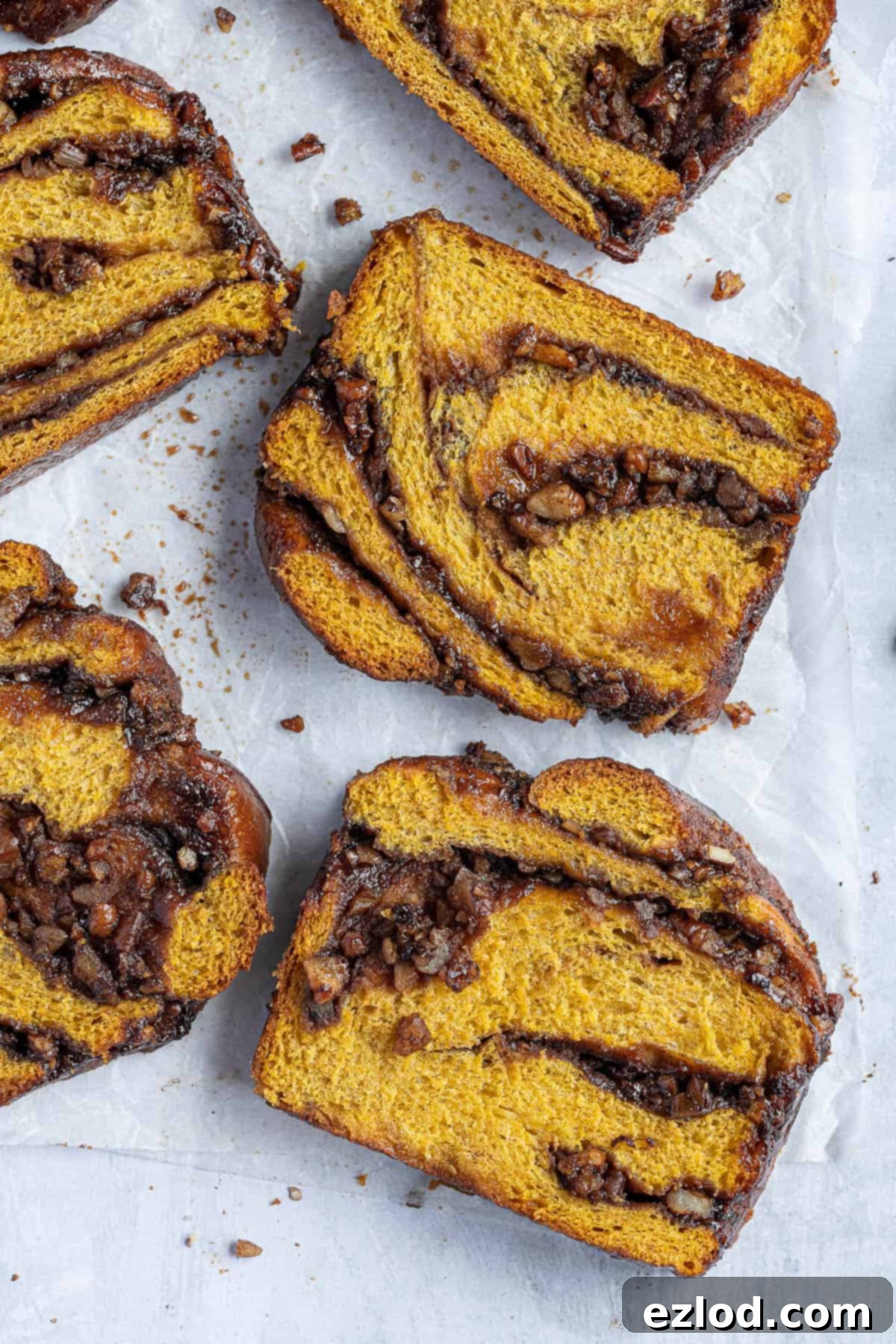
We hope you enjoy baking and savoring this delightful Vegan Pumpkin Pecan Babka! If you try this recipe, please let us know how it turned out. Rate it, leave a comment below, or tag @domestic_gothess on Instagram and use the hashtag #domesticgothess to share your beautiful creations.
All images and content on Domestic Gothess are copyright protected. If you want to share this recipe, please do so by using the share buttons provided. Do not screenshot or post the recipe or content in full; instead, include a link to this post for the complete recipe.

Print
Vegan Pumpkin Pecan Babka
Ingredients
Dough:
- 300 g (2 ½ cups) white bread flour plus extra as needed
- 40 g (3 Tablespoons) caster (superfine) sugar
- ½ teaspoon salt
- 7 g (2 ¼ teaspoons) instant/fast action yeast
- 120 g (½ cup) pumpkin puree
- 100 ml (⅓ cup + 4 teaspoons) unsweetened non-dairy milk
- 60 g (¼ cup) vegan block butter softened
Filling:
- 100 g (scant 1 cup) pecans
- 70 g (¼ cup + 1 Tablespoon) vegan butter softened
- 100 g (½ cup + 1 Tablespoon) light or dark brown soft sugar
- 1 Tablespoon pumpkin spice or cinnamon
- 1 teaspoon vanilla extract
- pinch salt
Syrup:
- 60 g (¼ cup + 1 Tablespoon) caster or granulated sugar
- 60 ml (¼ cup) water
Instructions
-
Ideally you should start the day before you want to bake the babka. Place the flour, sugar, yeast and salt in a large bowl or the bowl of a stand mixer fitted with a dough hook. Mix to combine.
-
Add the pumpkin puree and milk and mix to form a rough dough. Knead until it forms a smooth ball.
-
Add the softened vegan butter. Continue to knead until the butter is fully incorporated and the dough is smooth and elastic. It may seem greasy and messy at first but keep kneading and I promise you the butter will all mix in and the dough will become smooth.
-
Once the butter is fully incorporated the dough should look smooth and silky and it should pull away from the sides (but not the bottom) of the bowl cleanly. It should still be soft and sticky but if it seems too wet then you can knead in a little more flour; be careful not to add too much however.
-
Place the dough in a lightly oiled bowl, cover and leave to rise for 1 hour at room temperature then place it in the fridge to finish rising overnight.
-
The following day the dough should have doubled in size. Remove it from the fridge and set aside to warm up a little while you prepare the filling.
-
Chop the pecans very finely. Mix the softened butter, sugar, pumpkin spice, vanilla and a pinch of salt to a smooth paste then stir in the chopped pecans.
-
Punch down the dough and roll it out on a lightly floured surface to a rectangle about 30x40cm / 11x15in.
-
Spread the filling evenly over the dough, leaving a 1cm border. Roll the dough up tightly from one of the long edges into a sausage.
-
Use a sharp knife to cut the sausage in half lengthwise, exposing the filling. Twist the two halves together into a braid.
-
Grease an approx 11.5 x 21.5 cm / 4.5 x 8.5 in 2lb loaf tin and line it with baking parchment. Place the babka in the loaf tin, squishing it to fit if need be. Loosely cover the tin and set aside to rise until doubled in size, about 1 ½ – 2 hours depending on how cold it is.
-
It is ready to bake when it looks puffy and if you gently press some of the exposed dough with a finger it springs back slowly most of the way but leaves a small indentation. If it springs back quickly and fills in completely then it isn’t ready yet.
-
When the babka has nearly finished rising, pre-heat the oven to 180°C/160°C fan/350°F/gas mark 4.
-
Bake the babka for about 45-50 minutes until deep golden. A probe thermometer inserted into the centre should reach about 90°C/195°F when it is ready. If it starts to colour too quickly then loosely cover it with tin foil about half way through baking.
-
While the babka is baking prepare the syrup. Place the sugar and water in a small pan over a medium heat. Stir until the sugar has dissolved and the syrup comes up to a simmer. Remove from the heat and set aside.
-
When the babka is ready, remove it from the oven and brush generously all over the top with the syrup. Keep going until you have used all of the syrup.
-
Leave the babka to cool in the tin for 15-20 minutes while it absorbs the syrup then carefully lift it out onto a wire rack and leave to cool completely before slicing.
Notes
- See post above for additional tips, detailed explanations, and step-by-step photos. Many common questions are answered in the main article body!
- For consistent and accurate baking results, we strongly recommend using metric measurements with a digital scale rather than cup conversions, which can be highly imprecise.
- If you don’t have a stand mixer, the dough can be effectively kneaded by hand on an un-floured surface. Be prepared for it to be a bit sticky initially – that’s normal for enriched doughs!
- The finishing syrup is crucial for maintaining the babka’s moist texture for several days. Do not skip this step, and trust that the full amount of liquid will be absorbed to create a beautifully succulent loaf.
- To ensure your babka is perfectly baked through, use a probe thermometer. The internal temperature should reach 90°C (195°F) when done. Baking times are approximate due to oven variations.
- Patience is a virtue when cooling! It’s vital to allow the babka to cool completely before slicing. This allows the internal structure to set properly and prevents a dense or gummy texture.
